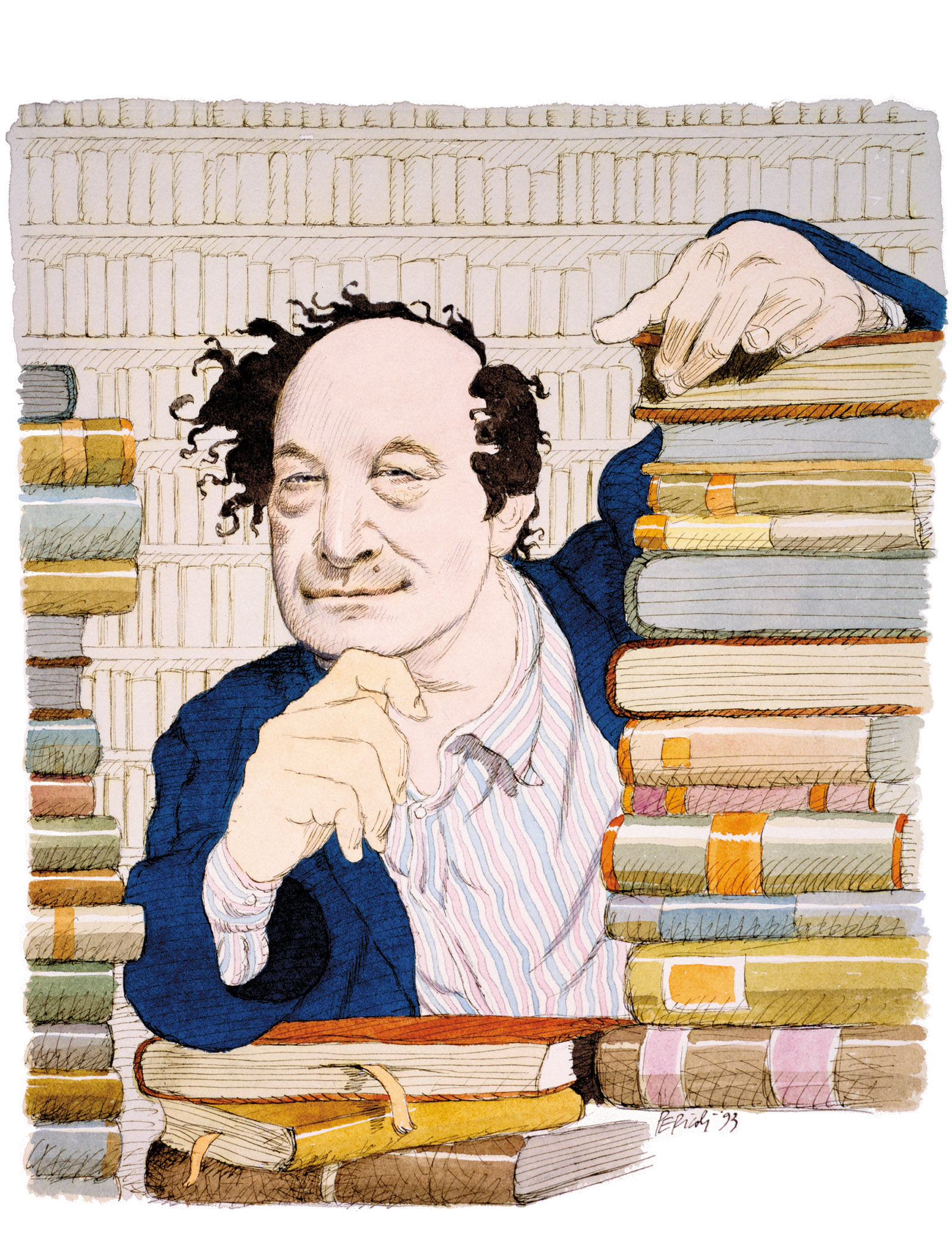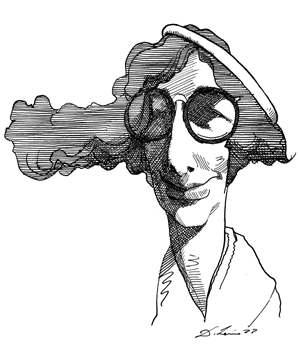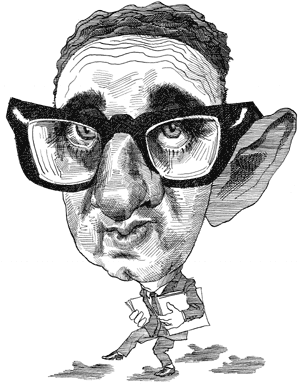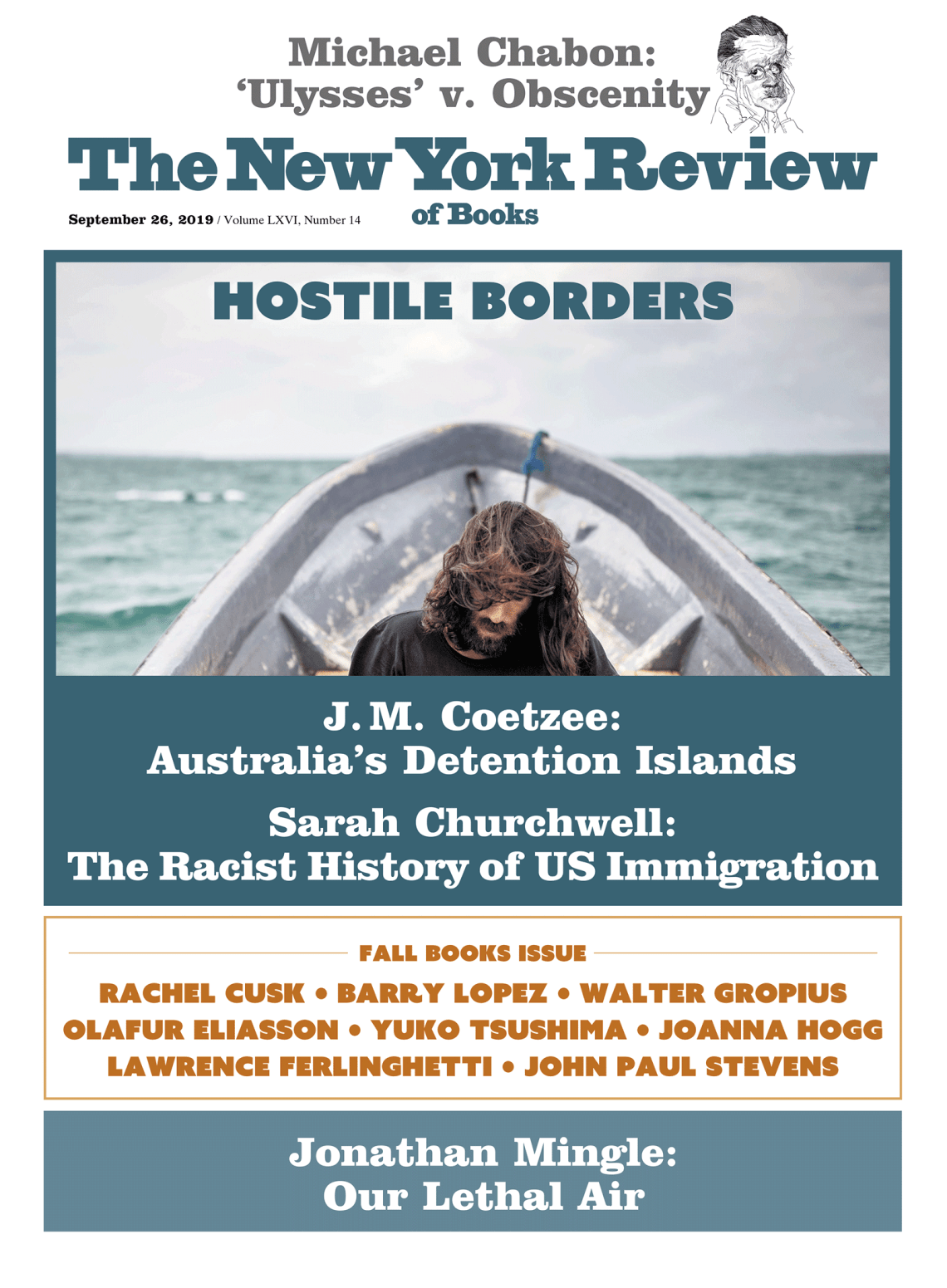The title of this slim book, the ninth part of Robert Calasso’s vast, ongoing project, is taken from the first volume of the series, The Ruin of Kasch, published in Italian—as La Rovina di Kasch—in 1983. The relevant passage goes, in part: “For those of us living at this moment, the most exact and most acute sensation is one of not knowing where we are treading from day to day…. We are living in the ‘unnamable present.’” Yet from the perspective of now, as we reel in mounting bewilderment from one jolting instance of political and social bizarrerie to the next, the world as it was in 1983 seems as solid as permafrost. The cold war was heading toward absolute zero, and in most places, including Calasso’s Italy, the old battle lines were as firmly scored as they had ever been, the fault lines as deep. A far cry, it would seem, from where we live today, in “a shattered world,” “even for scientists,” as Calasso writes.
Of course, this myriad-minded savant thinks not in decades but eons, and no doubt in his authorial eye thirty-six years are a barely noticeable blink. It can be assumed, therefore, that he refers back to those words of his published in 1983 not as evidence of his prophetic powers but as an indication of how things change and yet remain the same, sub specie aeternitatis.
Yet Calasso is keenly aware of the all-too-namable ills afflicting the contemporary world. His new book differs markedly from its predecessors not only in its brevity but in the urgency with which it addresses the burning issues—the raging inferno—of our time. Calasso is a scholar but not an academic—he heads the much-respected publishing house Adelphi Edizione in Milan—and as such is free to consider a dizzyingly wide range of topics, each leading on to and as often as not blending into the next. One moment we are among Islamic fundamentalists, the next we are being dazzled by the digital glare of Silicon Valley; here, Robert Frost is writing to Louis Untermeyer about art and revolution, there, Leonard and Virginia Woolf are taking tea in Bloomsbury with a chap from the Foreign Office who frightens them with tales of Hitler; now we are with Curzio Malaparte sheltering from Soviet bombs in Moldavia, then we are being warned by Joseph Goebbels of the pernicious Jewish gift for mimicry. Somehow, amazingly, it all hangs together.
The book is divided into three parts. The first, “Tourists and Terrorists,” is slightly longer than the second, sinisterly titled “The Vienna Gas Company,” while the third, “Sighting of the Towers,” is hardly more than a page in length—and we shall leave it unconsidered, so that it may detonate by itself for the reader with a most unexpected and astonishing report.
Calasso opens the first part by noting that between the years 1933 and 1945 “the world made a partially successful attempt at self-destruction” and observing that “what came after was shapeless, rough, and overpowerful.” So it might be that 1945 was in its way as momentous a date as 1933 or even 1914, for by the end of World War II, reality as it had been conceived of at least since the time of the Victorians had fallen apart at the center, as Yeats had said it must.
Calasso posits a continuity, or at least a similarity, between the immediate postwar period and our own, since the state of things in the new millennium is also shapeless and rough, and its effects are “ever more powerful.” The world of today, as represented to us by Calasso, is postmodern—to employ a term already out of fashion—a world that “has no style of its own but uses every style.” He concedes that to some, perhaps to many, this situation may be exciting and pregnant with possibilities of playful invention. However, “it excites only sectarians,” while the rest of us, the jittery agnostics, must adapt as best we can.
The title of the book’s first part, linking tourism and terrorism, may seem frivolous, but it is not.1 Calasso, as a latter-day scholastic, seeks to strike past mere effects in order to get at root causes. In the process he makes surprising and illuminating connections, not only between terrorism and tourism but also between, for example, the rise of Islamic mega-violence and the proliferation of online pornography:
What had always been dreamt of and desired was suddenly there to be seen, easily and always available. At the same time it tore away the whole structure of [the Islamists’] rules relating to sex. If that negation was possible, everything had to be possible. The secular world had invaded their mind with something irresistible, which attracted them and at the same time mocked and undermined them. Without the use of weapons—and, moreover, without assuming or needing the presence of meaning. But they would go further. And beyond sex, there is only death. A death stamped with meaning.
These humid cogitations may seem a far cry from the mythic serenity of The Marriage of Cadmus and Harmony (1988; English translation 1993), Calasso’s best-known and most popularly successful work, or his later volumes on Indian mythology,2 Vedic texts, the paintings of Tiepolo, and the writings of Kafka and Baudelaire. However, behind the intensity and richness of his prose3—think of Gibbon, of Frazer’s The Golden Bough, of the essays of T.S. Eliot—and the stoic grandeur of his conceits, there persists a single, cautionary theme. In all his books, Calasso’s intricate, veiled, sometimes subterranean argument is that we banish the old gods to our loss, and disregard at our peril those who still fanatically worship them.
Advertisement
The Unnamable Present opens with a brief but profound consideration of terrorism, particularly the Islamic variety, concentrated as it is on a hatred of secular society. “Terror,” Calasso writes, “is founded on the idea that only killing guarantees meaning.” What baffled the West following the destruction of the Twin Towers was the randomness of Islamist attacks and their almost exclusively suicidal nature; however, Calasso points out, the ultimate form of terrorism “is casual…the form of terrorism that most corresponds to the god of the moment.” Furthermore:
Islamic terrorism is sacrificial: in its perfect form, the victim is the bomber. Those who are killed in the attack are the beneficial fruit of the killer’s sacrifice…. Setting off some remotely controlled explosion obfuscates the sacrificial nature of the attack.
Calasso notes that the same ressentiment that drives present-day Islamists was as strong fifty years ago as it is today—indeed, as it was in the eleventh century, when the legendary “Old Man of the Mountain” sent his assassins, or “consumers of hashish,” off on their killing sprees. So why has Islamic terrorism taken on its present-day indiscriminate form? A theorist of the Web, Calasso theorizes, would see it as a direct effect of disintermediation, “of the fact that the world is tending to become instantaneous and simultaneous.”4 Why bother engaging on the battlefield with the military representatives of the secular world—descendants of the Crusaders—when you can attack that world directly, “preferably in its collective forms: tourism, entertainment, offices, museums, bars, department stores, public transport”?
Of course, the concept of the “blood sacrifice” as a mode of political action is hardly new and is certainly not exclusive to contemporary Islamist thinking. Calasso points out that a glance at The Last Days of Mankind, Karl Kraus’s chronicle of public life during World War I, will show that in Europe at the time of the great land battles in Flanders and elsewhere people referred as often to sacrifice as they did to military action. But even that offering up of millions of young lives was not enough. As Calasso writes, “There had to be another war—and, within it, a vast and horrifying operation of disinfestation, once again to pay off the sacrifice.”
Calasso identifies in the twentieth century “a process of enormous significance, which has affected all that goes under the name ‘religious,’” which was nothing less than the deification of society itself. The banished gods were to be replaced not with men, but with Man collectivized, a phenomenon characteristic of all forms of society, not only the Marxist version: “It is as though, after millennia, imagination had been stripped of its capacity to look beyond society in search of something that gives meaning to what is going on within society.” This provokes a bitterly witty formulation: “Theology ended up being transformed into politics, while theology itself was relegated to universities.”
The secularization of the West, Calasso suggests, was the result of a desire to regain a supposedly lost unity—a rage for order, as Wallace Stevens would have it—that existed not only in the conceptualizing minds of the likes of Marx and Rousseau, but also, as Calasso notes, of Saint-Simon, Hitler, Lenin, and, of course, the man-made god, Stalin. The ultimate aim of this unifying drive was to transform society into an organic whole, an aim on which even the fiercest opponents could agree. However, Calasso writes, “no one dares to say that the deprecated atomization of society can also be a form of self-defense from more serious ills.” Tyrants love unity, so long as those uniting do so in support of them.
One of the many pleasures of reading Calasso is to follow the bumper-car ride of his thinking, as he caroms off this and that totemic figure dotted about the intellectual fairground. Sometimes this can seem no more than supercharged name-dropping; in one five-line paragraph we hear of an epigraph from Nicholas de Staël in Betty Bouthoul’s Vieux de la Montagne, a book from which William S. Burroughs derived his obsession with Hasan-i Sabbah. Then there are the unlikely bedfellows who pop up from under all corners of the blanket. In the midst of a fascinating passage on Durkheim’s identification of society’s drive to become its own god, Simone Weil steps forward suddenly, like the conjuror’s Beautiful Assistant, to offer admittedly qualified support, while a moment later, just over the page, one is confronted by Henry Kissinger’s basilisk stare. Yet these names have voices. Weil comments on the “apparent kinship between the social and the supernatural, [which] to a certain extent justifies Durkheim”; Kissinger’s thinking on world order is seen as not a million miles away from the Vedics’ concept of cosmic order; and Hasan-i Sabbah was the Old Man of the Mountain. In Calasso’s world, “only connect” is only what things do.
Advertisement
Along with John Gray, Calasso is deeply skeptical of the advances claimed by leading figures in the contemporary life sciences. “Secular society,” Calasso writes, “has a tremendous fear of what has been its greatest discovery: relief and release from ritual and confessional obligations.” Instead of using this supposed newfound freedom to explore new ways of being and acting in the world, people in the West responded to the triumph of secularism by becoming “caught up in causes, whether good or bad,” one of the benefits of which is that the adherent is relieved of the burden of having to think as an individual:
But where can that which doesn’t renounce thought be accommodated? No longer in the university. Thought would benefit more than ever from a period of concealment, of a covert and clandestine existence, from which to reemerge in a situation that might resemble that of the Pre-Socratics.
Hmm. Might it not be that we would emerge from our concealed ivory bowers to find a world not waiting in eager anticipation of a new Socrates, but wholly under the sway of the great Moloch? Even in the most unpropitious of times, or especially then, surely it is imperative that thinkers not only think but be seen to be thinking, and acting on the outcome of their thought. In recent times we have witnessed how quickly control can fly out of the hands of the bien-pensants who consider themselves the guardians of the flame of freedom, the ones who, in the words of Tocqueville, appositely quoted by Calasso, imagine they are responsible for the actions of the individual and consequently undertake “to make him happy despite himself.” The easy political liberalism in which the West has indulged since at least 1989 has led to the laying bare of what Calasso identifies as “democracy’s open wound…the possibility of someone reaching power by legitimate means, but with the aim of abolishing democracy itself.” The obvious case Calasso points to is Hitler’s accession to power in January 1933, but contemporary examples of the same malign phenomenon are all too close to hand.
Calasso has a rich disdain for the species Homo saecularis, whose first prophet, he believes, was Jeremy Bentham, and whose “last missionary” was the behaviorist psychologist B.F. Skinner—with Locke as its “first gentleman.” Secularists bathe in spilt Christianity, “a timid and faint solution,” and imagine themselves rising up cleansed of all the old obfuscations while yet claiming for themselves an unshakable “spirituality.” But wherein, for them, does the spirit lie? Along with the milk of Christian kindness, disguised as the new humanism, the secularist insists on having his slice of Darwinian cake and eating it. In the name originally of Darwin, and latterly of Dawkins, the secularist repudiates the religious impulse while continuing devoutly to lay claim to spirituality: but where exists, Calasso asks, the “spirit” that confers its bounty of unsanctifying grace? “The result is that secularists speak with priestly compunction and priests try to pass themselves off as professors of sociology.”
Calasso finds a horrible source of fascination in the Web. Here, in this brave new world, where “information tends to replace not only knowledge, but thought in general,” the brave new word is that one already mentioned: “disintermediation.” Disintermediated Man can entangle himself in a series of algorithms and imagine he is thinking, whereas in fact it is more that he is being thought. At the start of the digital age, when the term “disintermediation” first appeared, it was enough “to tap in a certain sequence of words and anyone would have the impression of acting for themselves, without resorting to the usual tiresome intermediaries.” And, we may add, it was but a short step to a situation in which the individual, hunched over his keyboard, could consider himself a master of all knowledge, thanks to the Internet, and therefore no longer in need of priest, educator, or political analyst. As Michael Gove, the British MP and arch-Brexiter, would have it, Britain—read: the world—has had enough of experts. Homo saecularis is his own magister and magus.
Yet two wrinkles remain in the sheer fabric of the Web. As Calasso points out, the secular project, the democratic world itself, is premised on the notion of free will and the belief in science:
But science shows no sign of belief in the existence of free will. Indeed, on the basis of various arguments and experiments, it rejects it. Meanwhile, public life goes on as though this were not the case. Otherwise judicial, administrative, political, and economic systems would immediately grind to a halt. The dilemma is so serious that it is not recognized.
And behind this stumbling block is the boulder that is consciousness. As Calasso points out, intelligence can be simulated by machinery—a computer may defeat a chess grandmaster—but “consciousness is the invisible barrier against which information collides.” Consciousness is a quality, or state, exclusive to what William S. Burroughs—yes, him again—memorably designated “soft machines”: human beings, that is.5 This may be an annoyance to the Webmasters, but it should provide a crumb of comfort for the rest of us. It might be that a day is at hand when we will be “close to knowing almost everything we don’t need to know.” Calasso notes wryly that exactly a century separates Dadaism from Dataism, but while the former will continue to have its champions, “Dataism may come to be regarded one day as an instance of mass delirium.” Looking about on a bus or train nowadays and seeing everyone bent in rapt and reverent silence over a cell phone, it is hard not to be reminded of the moment of consecration in the Catholic Mass, or even of the Last Days of the Reverend Jim Jones.
If the first part of Calasso’s book is cast in the form of a subtly wrought admonition, the second is a sort of memento catastrophae. It consists of a series of extracts from letters, diaries, newspapers, etc., dating from the period 1933 to 1945, with comments and interpolations by Calasso. He emphasizes that these are not recollections but contemporary accounts of history-in-the-making. There is much here to shock, appall, disgust, astonish, depress. And echoes abound. For instance, in April 1939 the fascist-leaning writer Ernst Jünger is digging in his garden and, contemplating the worms his spade is cutting to pieces, reflects that “when man suffers without defense he can be compared to the worm.” Two years later, André Gide is also pottering among the plants, and observes that the only way to preserve the exquisite is “to suppress what is less good.” This may seem cruel, but “this cruelty is prudence,” a thought that leads him on to consider Hitler, “who wants to be the great gardener of Europe.” As Calasso restrainedly observes, “Perhaps no one, until then, had ventured to describe [Hitler] as such. But in Paris one always finds something more subtle, more polished than anywhere else.”
But the passage Calasso quotes here that is perhaps most apposite to our own times is from the American poet and professor of history Peter Viereck, whose father was a keen Nazi supporter, known as George Swastika Viereck. In June 1941 Peter Viereck began work on his book Metapolitics, subtitled “From the Romantics to Hitler.” In the introduction, he posed the “common question” as to whether men of the likes of Hitler are sincere “or only cynical gangsters laughing at their own stolen ideas.” He decides:
Here the real question is not either-or. Both the “either” and the “or” combine; that combination is a logical impossibility but a psychological fact. In other words, most successful frauds are sincere; most demagogues are honestly intoxicated by their own dishonest and cynical appeals.
Surely no one now could read these words and not be put immediately in mind of the self-satisfied and arrogant trumpery of these Late Days of Mankind.
This Issue
September 26, 2019
Australia’s Shame
Brexit: Fools Rush Out
‘Ulysses’ on Trial
-
1
Although humor, a bleak variety of it, is not to be disallowed: “The ideal tourist would like to visit places unmarred by tourism, in the same way that the ideal terrorist would like to operate in places unprotected by security measures. They both encounter certain difficulties. And have to put the blame on their fellows who have been before them.” ↩
-
2
See my review of Ka in these pages, January 14, 1999. ↩
-
3
Richard Dixon’s English translation is wonderfully supple and elegant. ↩
-
4
The proliferation of italics throughout the book is surely a mark of Calasso’s sense of urgency. ↩
-
5
It is a nice irony that William S. should have been a Burroughs of the Burroughs Corporation, mass manufacturer of hard machines. ↩





